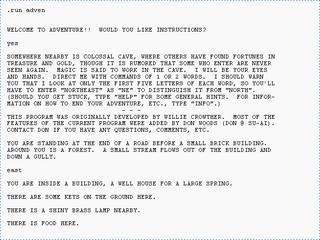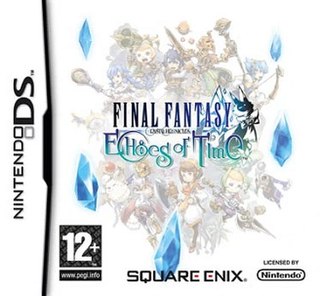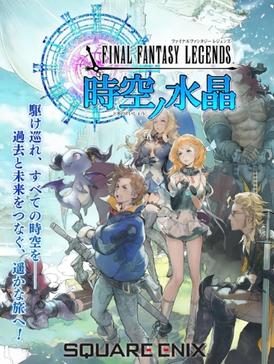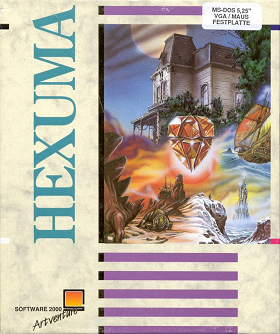
Fighting Fantasy is a series of single-player role-playing gamebooks created by Steve Jackson and Ian Livingstone. The first volume in the series was published in paperback by Puffin in 1982.

Final Fantasy Mystic Quest, released as Mystic Quest Legend in PAL regions and as Final Fantasy USA: Mystic Quest in Japan, is a role-playing video game for the Super Nintendo Entertainment System. The game was released as a spin-off to Square's Final Fantasy series of video games. Final Fantasy Mystic Quest was first released in North America in 1992 and marketed as a "simplified role-playing game... designed for the entry-level player" in an attempt to broaden the genre's appeal. The game's presentation and battle system is broadly similar to that of the main series, but it differs in its inclusion of action-adventure game elements. Final Fantasy Mystic Quest was the first Final Fantasy game to be released in Europe.

Pool of Radiance is a role-playing video game developed and published by Strategic Simulations, Inc (SSI) in 1988. It was the first adaptation of TSR's Advanced Dungeons & Dragons (AD&D) fantasy role-playing game for home computers, becoming the first episode in a four-part series of D&D computer adventure games. The other games in the "Gold Box" series used the game engine pioneered in Pool of Radiance, as did later D&D titles such as the Neverwinter Nights online game. Pool of Radiance takes place in the Forgotten Realms fantasy setting, with the action centered in and around the port city of Phlan.

Dizzy is a series of video games, created by the Oliver Twins and published by Codemasters. It was one of the most successful British video game franchises of the late 1980s and early 1990s. Originally created for the ZX Spectrum and Amstrad CPC, the series appeared on multiple home computer and video game console formats, with over a dozen games being published between 1987 and 1992.

Colossal Cave Adventure is a text-based adventure game, released in 1976 by developer Will Crowther for the PDP-10 mainframe computer. It was expanded upon in 1977 by Don Woods. In the game, the player explores a cave system rumored to be filled with treasure and gold. The game is composed of dozens of locations, and the player moves between these locations and interacts with objects in them by typing one- or two-word commands which are interpreted by the game's natural language input system. The program acts as a narrator, describing the player's location and the results of the player's attempted actions. It is the first well-known example of interactive fiction, as well as the first well-known adventure game, for which it was also the namesake.

Dungeoneer is the first of the three rule books that make up the Advanced Fighting Fantasy roleplaying game. It was written by Marc Gascoigne and Pete Tamlyn, illustrated by John Sibbick and was originally published in 1989. The system is based on Steve Jackson and Ian Livingstone's Fighting Fantasy series.

Atlantis: The Lost Tales is a 1997 fantasy adventure video game developed and published by Cryo Interactive Entertainment. Interplay Productions published the game in North America, where it released on September 30, 1997. The game is named after its initial and most important setting, Atlantis. It is the first in a Myst-like series, and was followed by Atlantis II, Atlantis III: The New World, Atlantis Evolution and The Secrets of Atlantis: The Sacred Legacy.

Final Fantasy Crystal Chronicles: The Crystal Bearers is an action-adventure game developed by Square Enix and released for Wii. It was released on November 12, 2009 in Japan and on December 26 in North America. The game received a mixed reception.

Dissidia Final Fantasy is a fighting game with action RPG elements developed and published by Square Enix for the PlayStation Portable as part of the campaign for the Final Fantasy series' 20th anniversary. It was released in Japan on December 18, 2008, in North America on August 25, 2009, and in Australia and Europe in September. It was then re-released in Japan, based on the North American version, as Dissidia Final Fantasy: Universal Tuning, on November 1, 2009.

Final Fantasy Crystal Chronicles: My Life as a King is a video game developed for the WiiWare service of the Wii console by Square Enix. Square Enix decided to make a game for the WiiWare service that would be high profile, and it was decided that the game would be a simulation game and, later in development, a Final Fantasy title.

Final Fantasy IV: The After Years is an episodic role-playing video game co-developed by Matrix Software and Square Enix, as the sequel to the 1991 title Final Fantasy IV. Set 17 years after Final Fantasy IV, The After Years follows the original cast and their descendants in episodic tales as a new villain appears, setting into action a mysterious chain of events that threatens the fate of the Blue Planet. Largely utilizing assets, locations, and mechanics from its predecessor, the title incorporates higher quality character graphics and several new gameplay systems.

Crystal Defenders is a set of two tower defense video games developed and published by Square Enix. The games use the setting of Ivalice and design elements from Final Fantasy Tactics A2: Grimoire of the Rift, forming part of the wider Final Fantasy franchise. The games feature a selection of characters sporting Final Fantasy-based character classes, and play out tower defense scenarios against recurring series of monsters. The first game in the series is Crystal Guardians, which was released in three parts for Japanese mobile phones in 2008. It was adapted for iOS later that year as Square Enix's first game for the platform, and renamed Crystal Defenders. Under that name, the game was also released between 2009 and 2011 for Android, Xbox Live Arcade, WiiWare, and PlayStation 3 and PlayStation Portable via the PlayStation Store. It was re-released with graphical improvements for iOS as Crystal Defenders Plus in 2013. A sequel, Crystal Defenders: Vanguard Storm, was released for iOS in 2009.

Final Fantasy Crystal Chronicles: Echoes of Time is a Wii and Nintendo DS action role-playing game in the Final Fantasy Crystal Chronicles series developed by Square Enix.

Lego Indiana Jones 2: The Adventure Continues is a 2009 action-adventure video game developed by Traveller's Tales and published by LucasArts. Based on the Indiana Jones franchise, it is the sequel to the 2008 video game Lego Indiana Jones: The Original Adventures. It was released for the Wii, Xbox 360, PlayStation 3, and Microsoft Windows; Feral Interactive published a version for Mac OS X in 2011. TT Fusion developed a handheld version for the Nintendo DS and PlayStation Portable that, although released under the same name, is different in gameplay and amount of content.
There have been several King's Quest fangames both original and retellings/remakes of the original games that have been released by various developers.

Blue's Birthday Adventure is an educational video game for children from the ages of 3–6 years of age. The game is based on the pre-school television program Blue's Clues, specifically the episode "Blue's Birthday". It was developed and published by Humongous Entertainment. The game is about how Steve tries to find three clues to figure out what Blue wants to have for her birthday.

The Lord of the Rings: The Card Game is a non-collectible customizable card game produced by Fantasy Flight Games. As part of the Living Card Game (LCG) genre, it is a cooperative and strategic card game set in Middle-earth, a fantasy world featured in literary works by J. R. R. Tolkien, including The Hobbit and The Lord of the Rings. Its digital adaptation, titled The Lord of the Rings: Adventure Card Game, is published by Asmodee Digital for cross-platform play on Microsoft Windows, macOS, PlayStation 4, Xbox One and Nintendo Switch, being the "first ever digital LCG".

Final Fantasy Dimensions II, also known as Final Fantasy Legends II: Jikuu no Suishō in Japan, is a free-to-play game developed by Matrix Software and published by Square Enix for Android and iOS devices. It is the second game released in Japan with the "Final Fantasy Legends" title after Final Fantasy Legends: Hikari to Yami no Senshi. It revolves around traveling through time in order to save the world from a god.

Hexuma, alternatively titled Hexuma: Das Auge des Kal is a German text adventure game published in 1992 by Software 2000 and developed by Weltenschmiede, and released for Amiga and DOS. Hexuma is the last entry in a text adventure trilogy; it is preceded by Das Stundenglas (1990) and Die Kathedrale (1991). The trilogy lacks an overarching plot, and in each entry the setting, role of the protagonist, and goal differ between each game. Games in the trilogy do not require knowledge of the other entries and may be played as standalone games.